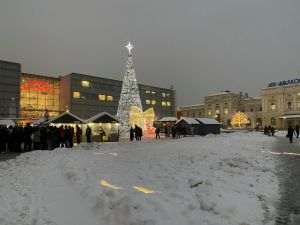The methods for rigging the elections are divided into two major categories:
1) the ones where the members of the commissions of the voting offices or militants of the various political parties, as well as the citizens, who receive a material benefit, act together;
2) the ones where the fraud is only committed by the representatives of the parties.
The best well known methods to defraud the vote are "electoral tourism", "the shuttle" or "the photo".
"Electoral tourism" means, transporting and bribing some citizens to vote in other cities than the ones where they reside (on the supplemental lists). The method is successfully used predominantly in the elections for the European parliament, or in the presidential ones, where there is a national electoral college, and voters can vote in any electoral office, not just the one in the town or city where they reside.
Some shipments are even organized for several cities. To a certain extent, electoral tourism is also used in the local and parliamentary elections, sometimes in combination with a previously initiated procedure, with the complicity of the authorities, of making ID cards for a certain city a few days in advance.
The "Photo" method means taking a photo of the voting bulletin with the "right" stamp on it in exchange for money.
"The shuttle". At least one voting bulletin gets stamped prior to the voting, with the control stamp and the "Voted" stamp on the box of a specific party or candidate. The voter who is involved in the fraud, gets a normal voting bulletin when he enters the voting office, but inserts the one that has already been stamped in the ballot box, takes the blank bulletin and hands it to another voter outside. The latter follows the same scheme, meaning that every voter illegally removes one voting bulletin from the voting office (the method is presented in detail in the article called "The ballot box as a cesspool").
The "Strawberry pickers". Prior research is conducted and "lists" are drawn up with the people who left to work abroad and who will be absent on the day of the vote. Subsequently, various people who are allowed to vote go to several locations and vote on the behalf of the former. Other times, the very members of the voting commission vote, sometimes before the opening of the ballot box, on behalf of the missing people, and then sign on their behalf and certify that the missing people came in to vote.
The "Shirt" method. The paid voter comes in to the voting office and claims that he is not able to vote by himself or that he can't read. He then asks to have someone accompany him in the voting booth. The voter and his companion enter the booth together. That companion has the task of making sure that the voting bulleting submitted by the voter is stamped with the "right" candidate, as previously agreed between the one who offered the bribe and the voter.
The "Shirt" method tends to be less used nowadays, due to the "success" of the "Photo" method. Furthermore, this year, the Central Electoral Bureau decided that not knowing how to read isn't a valid reason for the voter to go into the booth accompanied by someone else.
Another method for defrauding the elections consists of offering goods, money, food or various promises n order to determine the voter to vote for or against a specific candidate.
This is similar to the "Bible" method , frequently used in the rural areas, generally used with needy and faithful, preferably elderly people, who, in exchange for a modest amount, take a vow with their hand on the Bible that they will vote with the candidate they were advised to vote with.
The "Overcrowding" method. Crowding the doorway of the voting station by people specially prepared in that regard deliberately makes it hard for people or for the supporters of a specific party to vote. The method is used to obstruct the vote in the precincts where it is known that a specific party is likely to win.
• Fraud methods which involve the members of the voting offices and the representatives of the political parties exclusively
The excessive and undue use of the "mobile ballot box" and "the replacement ballot box". Usually, it is well known how many people (who are unable to move) will vote using the mobile ballot box. Once the travel between the locations of the various immobilized voters are concluded, the mobile ballot box is put in the trunk of the car which the two members of the voting office are moving around in, and is covered with a tarp. When they get to the voting office, a similar mobile ballot box is taken out of the trunk, with the previously estimated number of bulletins, but stamped in advance with the "right candidate".
The "cancelled" voting bulletins (considered as inadequate for the requirements of the electoral legislation which concerns the electoral legislation concerning the editing of the voting bulletins), or the unjustified cancellation of a voting bulletin. This usually happens with the small political parties which have no representatives in the voting offices, but it sometimes affects bigger parties as well. In this particular case, the representatives of the voting offices divide the number of bulletins to be counted among themselves and sometimes put the valid bulletins containing the votes in favor of their political opponents.
The "Fifty-fifty" method. The bulletins which remain unused can be divided between the representatives of the Office and inserted in the ballot box, each for their own party. This usually works in small voting offices, where there are no observers.
The "forgetful minds". It happens when the members of the Office deliberately forget to stick the self-sticking stamp on the ID card to prove that the person voted, thus allowing them to vote again.
The "Destruction" method. If the stamps with the "voted" inscription remain available to the members of the office after the conclusion of the vote and the opening of the ballot boxes, this allows the stamping of certain bulletins, which will then be cancelled.
The "Elastic band stamp" method. A forged stamp is tied around the wrist with an elastic band, and during the count, the bulletins containing votes of the "other" candidate are stamped, invalidating them. This method is widely used in the rural areas and in small towns. The stamp can also be stuck to the band of the wristwatch or to a ring.
The "Maradona" method. During some moments of carelessness of the colleagues in the voting office, certain bulletins are moved from one bunch to the other, thus altering the final count. It is used in the big voting offices, and when there are low odds of a recount.
But the most serious methods of electoral fraud are the ones by which the minutes containing the results of the vote.
"The home-made minutes". Predominantly used in the small, isolated towns or villages. The president of the voting office has a minutes prepared in advance. After the count, the people of the voting office get offered a something to drink to celebrate getting the job done, (the electoral process) and, while they are thus distracted, the forged minutes are given away to be signed, according to the anti-fraud manual of the PSD, obtained by NewsIn.
The "After vote" method. The preisdent of the voting office has a blank minutes form which he fills out and signs on the way from the voting office to the county electoral office.


















































